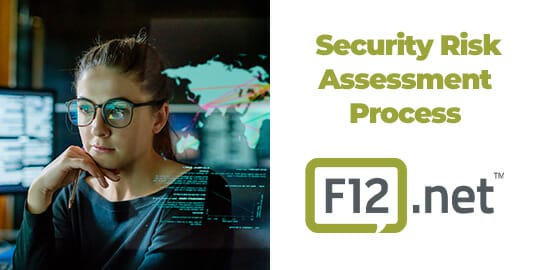
Table of Contents:
- How does a security risk assessment work?
- What problems does a security risk assessment solve?
- Why do I need a security risk assessment?
- What’s the difference between risk management and a security risk assessment?
- What are the elements of a security risk assessment?
- Which industries require security risk assessments?
- Enhancing your cybersecurity
Technology is developing rapidly. A key concern for businesses: cybersecurity. The digital landscape is full of threats and bad actors, and every day the news breaks of new data breaches and ransomware attacks. These risks make it crucial for businesses to proactively manage their security risks. That’s where a security risk assessment becomes critical.
How does a security risk assessment work?
A security risk assessment is a step-by-step process that evaluates an organization’s digital ecosystem. It identifies vulnerabilities and assesses risks, then develops strategies to mitigate them. It involves the following key steps:
Identify:
A security risk assessment begins by identifying potential threats and vulnerabilities within an organization’s IT infrastructure. Critical assets are determined and flagged. This helps to understand the scope of the organization’s digital landscape.
Assess: Once the digital landscape is established, the assessment team reviews each sector of the organization carefully to assess the probability and potential impact of exploitation from bad actors. Risk profiles are created and recognized threats are evaluated.
Mitigate: A mitigation plan is developed to address the identified risks. The plan outlines strategies and policies to reduce or eliminate vulnerabilities, enhancing the organization’s security posture.
Prevent: The prevention phase implements security measures and controls to prevent the identified vulnerabilities from being exploited.
What problems does a security risk assessment solve?
An organization undergoing a security risk assessment has the ability to proactively resolve issues — including problems that the company may not have even been aware of.
- Creating risk profiles for an organization’s individual sectors provides a wealth of information regarding the likelihood of exploitation of each asset.
- Prioritizing security efforts and resources allows organizations to allocate their budgets more efficiently. In addition, preventing security incidents is often more cost-effective than dealing with the aftermath of a breach.
- Ensuring compliance requirements are up to date helps organizations avoid legal and financial repercussions.
- Improving incident response plans (or developing previously non-existent ones) equips the organization to handle security incidents effectively, thereby minimizing damage.
Why do I need a security risk assessment?
A security risk assessment is not an unnecessary cost. There are many reasons why a security risk assessment makes good business sense.
- Not all assets are created equal. Identifying your most valuable assets is the first step, but knowing where they live in your IT infrastructure is even more important when it comes to cybersecurity. Who has access to these assets? How accessible are they? Is the current location a potential security issue?
- It provides a comprehensive picture of your organization’s vulnerabilities. It uncovers threats that might otherwise go unnoticed.
- It provides a plan. Don’t move forward without a plan! A security risk assessment can give an organization detailed insight into their vulnerabilities, strengths, and asset allocation within the IT infrastructure. Consequently, this knowledge promotes better-thought-out decision making around policy and strategy development.
What’s the difference between risk management and a security risk assessment?
While risk management and security risk assessment share the goal of protecting an organization’s assets, they differ in both scope and approach. A security risk assessment is a one-and-done snapshot of a company’s current cybersecurity infrastructure, whereas risk management is an ongoing process. Both are valuable.
Risk Management
Risk management has a wider scope than that of risk assessment. It encompasses a broader spectrum of risks like financial, operational, and strategic. Requiring a comprehensive strategy that may extend beyond cybersecurity, risk management focuses on managing risks and eliminating threats.
Security Risk Assessment
A security risk assessment specifically focuses on cybersecurity threats and vulnerabilities, evaluating them against an organization’s digital assets (after first identifying those assets). Its primary aim is to repair and strengthen cybersecurity measures.
In essence, while risk management is a broader organizational strategy, a security risk assessment is a subset of risk management focusing solely on cybersecurity risks.
What are the elements of a security risk assessment?
A successful security risk assessment comprises several key elements. At F12, we don’t settle for “good enough” when it comes to our clients. Our security risk assessment is a comprehensive process with many parts. With an F12 cyber security risk assessment, your organization receives:
- NIST framework review
- Internal and external assessment
- Open web application security
- Digital footprint score
- Comprehensive policy review
- Disaster recovery plan review
- Optional penetration testing
- Comparative scoring
- Live presentation of findings
- Prioritized calls to action
Which industries require security risk assessments?
Security risk assessments are crucial components of an organization’s cybersecurity across various industries. Here are a few sectors that benefit significantly from security risk assessments:
Healthcare
In the healthcare industry, safeguarding patient data is critical. Security risk assessments help healthcare providers and their organizations assess the security of their electronic record-keeping systems, medical devices, and networks. Compliance with regulations like the Personal Information Protection and Electronic Documents Act (PIPEDA) requires regular security risk assessments (and ongoing risk management) to protect patient confidentiality.
Payment Cards
The payment card industry has compliance requirements that call for security risk assessments for any organization that handles credit card data. In this industry, the assessments ensure that payment card information is securely processed, stored, and transmitted, thereby reducing the risk of data breaches and financial losses.
Public Companies
Publicly traded companies are often under scrutiny from their investors and relevant regulatory bodies. Investors want to know that compliance standards are being met — and exceeded. Security risk assessments help these businesses protect sensitive financial data, intellectual property, and customer information, in addition to reassuring investors and governing bodies that everything is up to code.
Enhancing your cybersecurity
Security risk assessments are so much more than an option; they are a necessity. Understanding their significance is the key to fortifying an organization’s cybersecurity defenses. By proactively identifying vulnerabilities, prioritizing critical assets, and implementing mitigation plans like threat hunting, an organization can reduce its risk of security breaches and avoid potentially devastating consequences.
Don’t wait for a bad actor to strike: take action today to protect your digital frontier by booking a security risk assessment. Talk to us to learn more.



